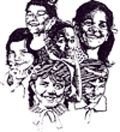| Approach:
One
to one |
Level:
Year
4
|
|
| Focus:
Solving
number problems using physical objects.
|
| Resources:
Two cue cards,
5 tens rods, 15 ones cubes, recording book. |
 |
108KB |
|
|
Questions
/ instructions:
Show cue card 1: Room 1 – 26 children
Room 1 at Tupai School has 26 children.
Place 5 rods and 15 cubes in front of the student. |

Room
1
26
children
|
|
|
|
|
%
responses
2001 ('97)
|
|
y4
|
| 1.
Can you show me 26 using these rods and cubes? |
arranged
2 tens rods and 6 ones cubes
|
92
(89)
|
2.
Is it possible that there could be the same number of girls as boys in
that class?
Prompt: If the student says “no”, ask why? |
yes,
initially
|
70
(63)
|
|
yes
|
8
(10)
|
3.
Use the rods and cubes to show me how many boys and how many girls there
would be in Room 1 if there was the same number of girls as boys.
Prompt: You could use two of the tens rods and six of the ones cubes. |
arranged
2 groups of 1 tens rod and 3 ones cubes
|
79
(76)
|
| 4.
Now tell me how many girls there are, and how many boys there are. |
13
|
80
(73)
|

Room
2
32
children
|
|
Put all of the rods and cubes back together.
Show cue card 2: Room 2 – 32 children.
Room 2 at Tupai School has 32 children. |
|
|
| 5.
Can you show me 32 using the rods and cubes? |
arranged
3 tens rods and 2 ones cubes
|
91
(88)
|
|
arranged
2 tens rods and 12 ones cubes
|
3
(4)
|
6.
Could there be the same number of girls as boys in that class?
Prompt: If the student says “no”, ask why? |
yes,
initially
|
56
(49)
|
|
yes
|
6
(8)
|
7.
Use the rods and cubes to show me how many girls and how many boys there
would be in Room 2 if there was the same number of girls as boys.
|
arranged
2 groups of 1 tens rod and 6 ones cubes
|
55 (43)
|
|
8.
Now tell me how many girls there are, and how many boys there are.
|
16
|
61(46)
|
Commentary:
The year 4 students enjoyed high success with this task until they were
required to rename from tens to ones in part 7. The 2001 students had
a small but consistent advantage over the 1997 students in parts 1 to
6, and a larger advantage in parts 7 and 8. |